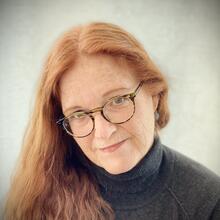“So I hesitate to tell you this, because the last time I gave you some news about your eyes, you wrote a column about me,” my optometrist said.
I had forgotten about that column from 15 or so years ago, which had to do with the dreaded news of my needing bifocals.
“Tell me anyway,” I said.
“You have the very tiniest beginning of a cataract in your left eye,” he said.
Cataracts are signs of decrepitude. Cataracts form in the cloudy eyes of my 12-year-old dog. Surely I am too young for a cataract.
A cataract! Oh, unhappy day. Cataracts are signs of decrepitude. Cataracts happen to my mother-in-law. Cataracts form in the cloudy eyes of my 12-year-old dog. (That’s 72 in people years.) Surely I am too young for a cataract.
My doctor retrieved the model of the big eye from his desk. He slipped a clear plastic disc from a slot in front of the staring eye. “This is the lens of your eye,” he explained, “between the iris and the pupil. When we are young, it is flexible and clear.”
I appreciated the “we” reference. Still, I did not like where this conversation was going. I had gone into my yearly appointment feeling reasonably middle-aged and was leaving as an old woman.
I had gone into my yearly appointment feeling reasonably middle-aged and was leaving as an old woman.
“As we age, the lens becomes brittle and eventually gets discolored. That’s a cataract.”
The eye glared at me. “It’s like when you have a 10-year-old car, and you notice that the headlights have gotten fogged over,” he said. “Sort of like that. But the lens of your eye can be replaced. It’s a fairly easy operation.”
“So when do I need surgery?’ I asked.
“When it bothers you,” he said. “You’ll know.”
Will I? Or will I just get used to muted and cloudier vision?
I have noticed the tendency of other parts to become brittle and inflexible as we age. Our bones. Our learning curve. Our hearts.
I have noticed the tendency of other parts to become brittle and inflexible as we age. Our bones. Our learning curve. Our hearts. We get set in our ways, and we become resistant to change, at a time when things are definitely changing. It occurs to me that maybe we develop cataracts on the soul.
The wonder and awe in which we bask when we are children can become jaded as we start to take the blessings and miracles of life for granted. The first time we see the ocean or a dragonfly or a skyscraper or an actual cow can be a staggering experience. But can we remember that far back? Then, as teenagers, we go out of our way to be unimpressed by things we once thought magical. Is adolescence the foretelling of soul cataracts?
Cataracts, both physical and spiritual, can be cured.
As we mature, we are obsessed with making our living, making our families, making our way in the world, making our lasting mark. By the time we are old, everything can seem mundane. Or disappointing. Or permanent. We have suffered setbacks and disillusionment, rejection and failure. We have mourned losses that break our hearts and challenge our faith in a loving God. All of these things can cloud the eyes of our souls. They can lead to spiritual blindness.
How do we break through those spiritual cataracts? What surgery of the soul can restore the clarity of God’s love and plans for us? Perhaps we would do well to find new ways to pray, to bring ourselves into a fresh and lucid intimacy with God. Perhaps we can remove the clouded lens of our soul by a conscious attempt to see anew the ways in which God invites us to delight in all creation, the small joys and wonders that surround us every day and that we have not taken the time or the care to notice for years. Perhaps our souls will again become crystal clear if we can see our way to accept changes and to be curious and to embrace life’s surprises.
Cataracts, both physical and spiritual, can be cured. The cool thing, according to my optometrist, is that when the cataract surgery is complete, the patient often no longer needs glasses. Advances in the field mean that the replacement lens might even function as a bifocal in the future. For someone who’s worn glasses since the fourth grade, this is welcome news. I may be wrinkled and bent by the time I go under the eyeball knife, but my vision will emerge as 20/20.
And what then of my brittle soul? Perhaps if I follow my own advice, it, too, may become flexible and transparent again, as it allows itself to go with the flow and to go with God.










